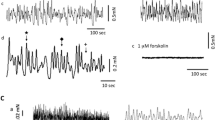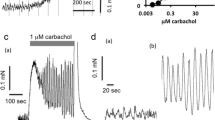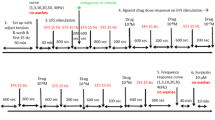Abstract
We investigated whether in human isolated detrusor strips the atropine-resistant contractile response to electrical field stimulation was mediated by ATP (or a related purine), as previously shown in the urinary bladder of other mammalian species. Electrical stimulation (1–50Hz for 5s at 1min intervals, 0.1ms pulse width, 60V) elicited reproducible, frequency-dependent twitch contractions, which were markedly reduced by atropine (10μM). Tetrodotoxin (TTX: 1μM) inhibited contractile responses to a similar degree. When applied together, atropine and TTX caused an inhibition which was superimposable to that caused by either drug alone. The TTX-resistant contractions were totally unaffected by omega-conotoxin GVIA (ω-CTX: 0.1μM). The atropine-resistant contractions were unaffected by the P2-purinoceptor antagonists suramin (300μM) and PPADS (30μM), at concentrations which virtually suppressed the contractile response induced by applied ATP (10μM–1mM). As previously described, antagonism of the ATP-induced contractions by suramin (30, 100, 300μM) and PPADS (3, 10, 30μM) was insurmountable, with apparent ‘pA2’ values (calculated at the lowest antagonist concentrations) of 4.9 and 5.2, respectively. It is concluded that, under our experimental conditions, the non-cholinergic (atropine-resistant) component of the excitatory transmission in the human detrusor is not mediated by neural release of ATP, in spite of the presence of excitatory P2-purinoceptors on the effector cells. The TTX- and ω-CTX-resistant, non-cholinergic component might be related to the release of unknown transmitter(s) through a mechanism independent of both Na+- and N-type Ca2+-channels. More likely, the atropine-resistant component may reflect direct smooth muscle excitation since the human detrusor has a very short chronaxie (Sibley 1984).
Similar content being viewed by others
Author information
Authors and Affiliations
Additional information
Received: 26 June 1997 / Accepted: 26 August 1997
Rights and permissions
About this article
Cite this article
Tagliani, M., Candura, S., Di Nucci, A. et al. A re-appraisal of the nature of the atropine-resistant contraction to electrical field stimulation in the human isolated detrusor muscle. Naunyn-Schmiedeberg's Arch Pharmacol 356, 750–755 (1997). https://doi.org/10.1007/PL00005114
Issue Date:
DOI: https://doi.org/10.1007/PL00005114




